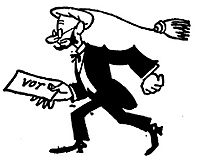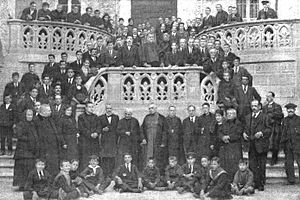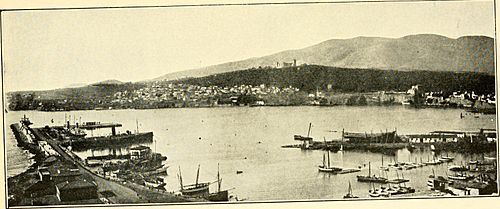Pedro Llosas Badía facts for kids
Quick facts for kids
Pedro Llosas Badía
|
|
|---|---|
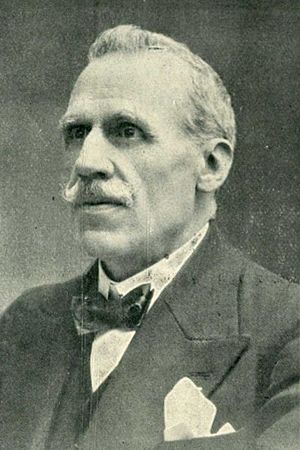 |
|
| Born |
Pedro Llosas Badía
1870 |
| Died | 1955 Olot
|
| Nationality | Spanish |
| Occupation | banker |
| Known for | politician |
| Political party | Carlism, UP |
Pedro Llosas y Badía (1870–1955) was an important Spanish politician. He was active in Catalonia, a region in Spain. First, he was part of the Carlists, a group that supported a different royal family. Later, he worked with the government of Primo de Rivera. Pedro Llosas was the Carlist politician who served the longest in Catalonia during a time called the Restoration. He is best known for being the civil governor of La Coruña and the Balearic Islands during a period when Spain was ruled by a dictator.
Contents
Early Life and Education (1870-1893)

Pedro Llosas Badía came from a family in Catalonia. His family had a long history in the textile business, making cotton fabrics. His grandfather, Juan Llosas Pujol, was from Olot in Girona. Pedro's father, Juan Llosas Tenas, worked in the textile business in Albacete for many years.
Later, his father returned to Olot and married Rosa Badía Trull. Pedro was their only child. Sadly, his father passed away when Pedro was very young.
In 1882, Pedro went to a school called Seminario-Colegio de Santa María del Collell. This school offered both religious and business studies. He finished school in 1887 and then studied at the University of Barcelona. In 1890, he graduated with excellent grades. His studies focused on history, and he was very interested in archeology later in life.
Family and Business Life
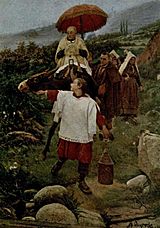
In 1893, Pedro Llosas Badía returned to Olot and married Anna Serat-Calvó y Plana. They had six children together. However, their family faced many sad times as four of their children passed away young. One of his daughters, Rosa, married Joaquin Vayreda Aulet, whose father was the famous painter and author Marian Vayreda.
Pedro and Anna had two children who lived to adulthood: Martirián and Miguel. Martirián Llosas y Serrat-Calvó became a judge and worked with juvenile courts. Miguel Llosas y Serrat-Calvó also became a judge and was known for his writings on history and culture.
In 1895, Pedro and some relatives started a local bank called Banco Llosas, Escubós y Puigmitjà. This bank was very successful and stayed in their family until the mid-1920s.
Joining the Carlists

In the late 1800s, Olot was a strong center for the Carlist movement. This movement supported a different branch of the Spanish royal family. Pedro Llosas became very involved in local Carlist and Catholic groups. In 1891, he was the secretary of the local Catalanist Center, and by 1892, he was its vice-president. He also became the president of the local Carlist club.
Pedro was a good speaker and writer. He wrote for local newspapers like L’Olotí and El Deber, sharing his thoughts on culture and history.
Political Career in Olot
In 1897, Pedro Llosas was elected to the Olot town council (ayuntamiento). He quickly became an important member, serving as a deputy mayor and leading different committees. In 1900, he even served briefly as the mayor of Olot.
In 1903, Llosas was elected to the provincial government of Girona. He served as a representative (diputado) until 1907. In this role, he supported a Traditionalist view of regionalism. He believed in Catalan identity and spoke Catalan in the chamber, which was unusual at the time. He also helped start a new Carlist newspaper in Olot, La Tradició Catalana.
Serving in the Spanish Parliament
In the mid-1900s, Llosas decided to run for the Spanish Parliament (Cortes). The Olot area often voted for Carlists. In 1907, the Carlists joined forces with other groups to form Solidaritat Catalana. This alliance helped Llosas get elected to the Parliament. He was one of seven Carlists elected from Catalonia.
Even after this alliance ended, Llosas continued to win elections in Olot in 1910, 1914, and 1916. He was a member of a small Carlist group in Parliament. His work in Parliament mostly focused on defending the Catholic Church and promoting Catalan identity. He was seen as a representative of a new kind of Carlism in Catalonia. In 1912, he joined the national leadership of the Carlist party.
Challenges and Changes
By the late 1910s, the Carlist movement in Catalonia started to break apart. There were disagreements among members about leadership and about how much to support Catalan identity. Pedro Llosas, despite his loyalty, also faced these challenges.
In 1917, Llosas took part in the Parliamentary Assembly. This was a meeting of many politicians, mostly from Catalonia, who wanted to change the political system. Even though the Carlists officially decided not to join, Llosas participated on his own. Some people thought he left the party, but others said the Carlists later supported the Assembly's ideas.
The 1918 election was very confusing. Another political group, La Lliga, decided to run against Llosas in Olot. The Carlists themselves were divided into three groups. Llosas ran as an independent, but people still called him a "Carlist." He seemed to lose the election by a small number of votes. He claimed there was corruption, but after investigations, he was declared defeated.
When a major conflict happened within the Carlist party in 1919, Llosas tried to stay neutral. He was influenced by some leaders who wanted to form large conservative alliances. He did not fully join either side of the Carlist split. Instead, he became closer to the right-wing of the Conservative Party. In 1919 and 1921, he ran unsuccessfully for the Senate.
In October 1921, the prime minister appointed Llosas as the civil governor of the Balearic Islands. He was known for being firm in his decisions. He resigned from this position in April 1922 and returned to Olot.
Working with Primo de Rivera

Pedro Llosas supported the military takeover by General Primo de Rivera in 1923. In 1924, he helped set up the new political party, Unión Patriótica, in Olot.
Also in 1924, he was appointed to two important Catalan self-government bodies: the provincial government of Girona and the Permanent Council of Mancomunitat de Catalunya. He became the president of the Girona provincial government. In the Mancomunitat, he worked to protect the Institut d'Estudis Catalans and supported teaching Catalan in schools. He also helped develop local libraries.
In 1924, the Girona government, led by Llosas, sent a document to Primo de Rivera. This document argued against centralizing power and promoted a strong regional government for Catalonia. Llosas wanted Catalonia to be organized like the Basque Country, with power centered in the provinces. However, his ideas were not fully accepted, and he resigned as head of the Girona government. He continued to help with the process of phasing out the Mancomunitat until it ended in 1925.
Despite some disagreements, Llosas remained on good terms with Primo de Rivera. In May 1925, he was appointed civil governor of La Coruña province. He was known for his firm approach to governing. He resigned in April 1926 due to health reasons. The same year, he became the civil governor of the Balearic Islands again, based in Palma. He worked on cultural activities, public works, and building new railway lines. When Primo de Rivera resigned in 1930, Llosas was not re-appointed and returned to Olot to focus on his family and business.
Life During the Republic and Francoism
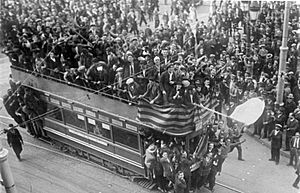
Pedro Llosas was a wealthy man. He managed the Olot branch of Banco Hispano Americano, which had taken over his family's bank. He was known as a banker and property owner. He was a respected figure in Girona, and many people visited his home seeking his help.
However, his position changed greatly when the Second Spanish Republic began in 1931. As someone who had worked with the dictatorship and was a monarchist, he lost his political influence. A street named after him in Santa Pau was immediately renamed "Via de la República."
Llosas then focused on religious activities. He participated in Catholic events and wrote for religious newspapers. In 1933, he led a large group of Catalans on a visit to the Vatican. He also reconnected with the Carlists, writing historical and religious articles for their newspapers. In early 1936, he attended monarchist meetings with other Catalan Carlists.

Llosas welcomed the military uprising in July 1936. During the Civil War, Olot was controlled by Republican groups. His family's mansion was damaged, but he survived the war. After the Nationalists took control of Catalonia in February 1939, Llosas offered his help to the new government. He was asked to gather business leaders in Girona to help with post-war rebuilding. However, he was not involved in official activities much after the early months of Francoism in Catalonia.
In the 1940s and later, Llosas continued to be involved in religious initiatives. He also wrote historical articles, often about religious topics, for the newspaper ¡Arriba España!. By 1949, he became seriously ill. When he passed away in 1955, his funeral was attended by many important people, including the mayor of Olot and leaders of the Carlist movement. His obituary said he had always been a Traditionalist.
See also
 In Spanish: Pedro Llosas Badía para niños
In Spanish: Pedro Llosas Badía para niños
- Carlism
- Catalanism
- Marian Vayreda i Vila
- Solidaritat Catalana
- Assemblea de Parlamentaris
- Mancomunitat


